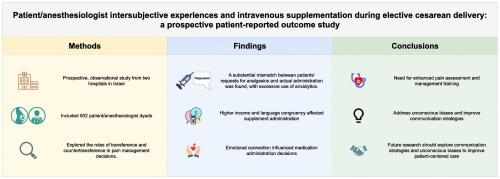Patient/anesthesiologist intersubjective experiences and intravenous supplementation during elective cesarean delivery: A prospective patient-reported outcome study
IF 5
2区 医学
Q1 ANESTHESIOLOGY
引用次数: 0
Abstract
Introduction
This prospective, observational study investigated the impact of patient/anesthesiologist interactions and socioeconomic factors on administering intravenous analgesics and anxiolytics during elective Cesarean delivery under spinal anesthesia. The study explored the role of emotional experiences and psychosocial characteristics on intraoperative administration of intravenous adjuncts.
Methods
The study included 502 patient/anesthesiologist dyads from two hospitals in Israel. Patients and anesthesiologists completed questionnaires assessing pain, anxiety, medication requests, and subjective experiences. Logistic regression models were used to analyze associations between variables and medication administration.
Results
Out of 502 patients, 110 (21.9 %) received intravenous supplementation. Only 40.6 % of patients who requested analgesics received them, while anxiolytics were administered four times more often than analgesics. Patients with higher salaries and those speaking the same language as the anesthesiologist were less likely to receive supplementation. Anesthesiologists feeling more attached to or close to patients were more likely to administer medication, while those motivated to protect patients were less likely.
Conclusion
The study revealed a substantial gap between patient requests for analgesics and their administration, as well as an overreliance on anxiolysis compared to analgesia. Unconscious attitudes related to patient factors and subjective physician perceptions played a role in medication decisions. The findings emphasize the need for better pain assessment and management training, and awareness of implicit biases in healthcare settings. Future research should investigate optimal communication strategies and address unconscious attitudes to improve patient-centered care.

择期剖宫产过程中患者/麻醉师的主观体验与静脉补充:前瞻性患者报告结果研究
简介:这项前瞻性观察研究调查了脊髓麻醉下择期剖宫产过程中患者/麻醉师互动和社会经济因素对静脉注射镇痛药和抗焦虑药的影响。该研究探讨了情感体验和社会心理特征对术中静脉注射辅助药物的作用。研究方法该研究包括来自以色列两家医院的 502 个患者/麻醉师二人组。患者和麻醉师填写了评估疼痛、焦虑、用药要求和主观体验的问卷。结果 在 502 名患者中,有 110 人(21.9%)接受了静脉补充治疗。只有 40.6% 的患者要求使用镇痛药,而抗焦虑药的使用频率是镇痛药的四倍。工资较高的患者和与麻醉医师讲同一种语言的患者接受补充药物的可能性较低。该研究显示,患者对镇痛药的需求与用药之间存在巨大差距,而且与镇痛药相比,过度依赖抗焦虑药。与患者因素相关的无意识态度和医生的主观看法在用药决定中起了一定作用。研究结果表明,有必要加强疼痛评估和管理培训,并认识到医疗机构中的隐性偏见。未来的研究应调查最佳的沟通策略并解决无意识态度问题,以改善以患者为中心的护理。
本文章由计算机程序翻译,如有差异,请以英文原文为准。
求助全文
约1分钟内获得全文
求助全文
来源期刊
CiteScore
7.40
自引率
4.50%
发文量
346
审稿时长
23 days
期刊介绍:
The Journal of Clinical Anesthesia (JCA) addresses all aspects of anesthesia practice, including anesthetic administration, pharmacokinetics, preoperative and postoperative considerations, coexisting disease and other complicating factors, cost issues, and similar concerns anesthesiologists contend with daily. Exceptionally high standards of presentation and accuracy are maintained.
The core of the journal is original contributions on subjects relevant to clinical practice, and rigorously peer-reviewed. Highly respected international experts have joined together to form the Editorial Board, sharing their years of experience and clinical expertise. Specialized section editors cover the various subspecialties within the field. To keep your practical clinical skills current, the journal bridges the gap between the laboratory and the clinical practice of anesthesiology and critical care to clarify how new insights can improve daily practice.

 求助内容:
求助内容: 应助结果提醒方式:
应助结果提醒方式:


